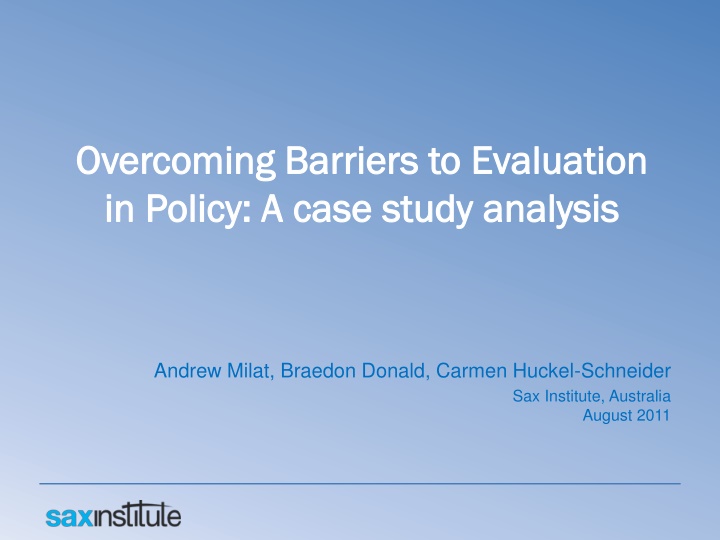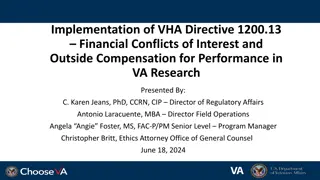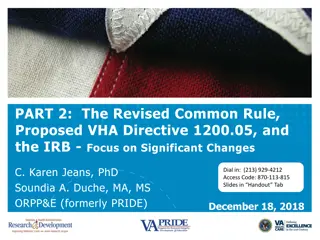
Barriers to Evaluation in Policy: A Case Study Analysis
Explore the challenges faced in evaluating policies and programs that aim to improve various aspects of society. Delve into the critical need for effective evaluation services and the barriers hindering the thorough assessment of interventions. This case study analysis sheds light on the complexities and deficiencies in the evaluation process, offering valuable insights for policymakers and researchers.
Download Presentation

Please find below an Image/Link to download the presentation.
The content on the website is provided AS IS for your information and personal use only. It may not be sold, licensed, or shared on other websites without obtaining consent from the author. If you encounter any issues during the download, it is possible that the publisher has removed the file from their server.
You are allowed to download the files provided on this website for personal or commercial use, subject to the condition that they are used lawfully. All files are the property of their respective owners.
The content on the website is provided AS IS for your information and personal use only. It may not be sold, licensed, or shared on other websites without obtaining consent from the author.
E N D
Presentation Transcript
Overcoming Barriers to Evaluation Overcoming Barriers to Evaluation in Policy: A case study analysis in Policy: A case study analysis Andrew Milat, Braedon Donald, Carmen Huckel-Schneider Sax Institute, Australia August 2011
Sax Institute Independent not-for profit organisation. Receive core funding from NSW Department of Health. Mission is to improve the health and health services of Australians by promoting the use of research in policy making. 2
Presentation Outline 1. 2. 3. 4. 5. 6. 7. 8. Case study Case study 9. Lessons learned 10. Implications 11. References Background A need for Evaluation support services What is E-make? E-make strategic development Reflections on experiences to date Research objectives Methods Results 3
1. Background Annually billions of dollars are invested in programs to improve health, social welfare, education and justice. Yet we know little about the effects of most of these attempts to improve people s lives (Oxman, 2010). 4
UKs House of Commons Health Committee (2009) The most damning criticisms of Government policies we have heard in this inquiry have not been of the policies themselves, but rather of the Government s approach to designing and introducing new policies which make meaningful evaluation impossible. Even where evaluation is carried out, it is usually soft , amounting to little more than examining processes and asking those involved what they thought about them...As a result...we have wasted huge opportunities to learn (p. 5) 5
1. Background (contd) Only a small proportion of peer reviewed literature reports results of interventions (in particular the evaluation of policies and programs) (Sanson-Fisher et al 2008; Milat et al Submitted) There remains a paucity of literature that examines: Why so few evaluations are conducted? Barriers and enablers experienced by Australian policy makers and researchers (evaluators) in initiating evaluations. Processes, skills and resources required to initiate high quality evaluations. 6
2. A need for evaluation support services Anecdotally policy makers report substantial barriers to commissioning high quality and timely evaluations of policies and programs. The Sax Institute has been approached by a number of policy agencies to assist them with planning evaluations of health programs/policies. In response to these needs the Institute developed a new service Evidence Make for Evaluation (E- make). 7
When it comes to the (inevitable) use of external contractors, I think we need to give far more attention to defining the task, and to identifying how contractors can best help us to make good public policy. Gary Banks, Chairman of the Australian Productivity Commission 2009:21 8
3. What is E-make? Provides policy agencies with expert advice in order to clarify their evaluation questions and summarise evaluation needs. Use expertise of an experienced Evaluation Adviser (academic researcher). Process contains a series of steps, which culminates in the development of an Evaluation Brief. The Institute does not conduct evaluations, rather it provides advice that is used to facilitate the conduct or commissioning high quality evaluations. 10
E-make process KNOWLEDGE BROKERING SESSION FINAL E-MAKE SCOPE FINALISED DRAFT EVALUATION BRIEF EVALUATION BRIEF COMMISSIONING TOOL Evaluation Adviser allocated to meet with policy agency to discuss the program or policy and the potential evaluation The final costs, timeframe and scope of the Evaluation Brief are agreed. After Policy agency completes tool that asks various questions that will be important in clarifying the scope of the Evaluation Brief The addressing policy maker's comments the finalised Evaluation Brief is provided. Knowledge Broker will prepare a Draft Evaluation Brief for Comment 11
4. E-make strategic development 1. Literature Review Key word search using electronic databases (Pub Med and Medline) published since 1995 and search of grey literature. 2. Research Study into the use of evaluation in policy Up to n=20 semi structured interviews with senior policy makers and researchers. 3. Reflection of experiences to date providing advice to policy agencies In depth semi-structured interviews with policy makers and Evaluation Advisers (researchers). 13
5. Reflections on experiences to date 6 E-Makes conducted for policy agencies to date. 4 E-Makes are used for the basis of this study. 2 E-Make case studies presented. 14
6. Research objectives case study analysis Objectives: To understand why policy agencies engage assistance to plan evaluations. To determine the outcomes of the provision of E-make advice. Improve the quality and usefulness of advice given to policy agencies through E-make. 15
7. Methods i. In-depth interviews with: 4 policy makers 2 Evaluation Advisers. ii. Analysis of primary documents including E-make commissioning tool, correspondence, draft and final evaluation briefs. iii. Thematic analysis in terms of: Engagement Process Outcomes Cross-cutting themes or issues. 16
8. Results 17
Case 1: Tendering an evaluation of a state-wide health service program A state-wide program to improve quality of care and life of people with chronic disease. Multi-site program implemented at a regional level. Involved multiple government partner agencies. Starting point for the agency was a draft project specification and terms of reference for evaluators. 18
Case 1: Tendering an evaluation of a state-wide preventive program Engagement Institute approached to appraise, improve and finalise tender documents, with a focus on: Realistic scope and methodological rigour Assessment criteria Determine appropriate language to attract a broad range of candidates. Process Evaluation Adviser was an internal Institute staff member Most communication via email Involvement of clients partners on commenting on drafts. Outcomes Four high quality applicants from academic (3) and consultancy sectors (1). A university-based research team appointed. 19
We wanted to clarify what were the things we really wanted to evaluate, and put it in a format that would be appealing to the research sector, speak their language and hopefully increase the number of and quality of people tendering for the job. Policy Maker 20
Case 1: Notable Issues Advanced in their thinking. Managing competing, and conflicting, interests. Differing preferences for mode of communication: From Evaluation Adviser perspective communication over email with no face-to-face dialogue was difficult, whereas policy makers found it appropriate and efficient. 21
Case 2: Evaluation Options for a GP support program A state-wide program that involved various strategies and tools to support GPs to detect and manage common infectious diseases within their practices. Looking to evaluate the roll-out of this program. Seeking unbiased, new and objective perspective for ideas about the evaluation. Starting point for the agency was very early stages of considering evaluation, including brainstormed specific evaluation questions. Had previously sought advice from other agencies. 22
Case 2: Evaluation Options for a GP support program Engagement Institute approached to help: Clarify scope of evaluation Determine evaluation questions Explore methods and feasibility of approaches Provide innovative evaluation ideas. Process A commissioning tool used for needs assessment and provision of information 1st time. Engagement of an external evaluation adviser (academic researcher) with evaluation expertise. Brokering session held. Brokerage between evaluation adviser and policy maker conducted by the Institute. Outcomes Evaluation Options paper as final deliverable. Evaluation successfully tendered to a university-based research team. 23
Case 2: Notable issues Need to invest time in clarifying the scope and nature of advice required up front. Translating Evaluation Adviser advice into policy appropriate language was required. Brief confirmed previous advice and gave them confidence necessary to move forward with the evaluation. 24
Solidified our understanding and knowledge about evaluation, and clarified thinking about what an evaluation could and should look like...[it] helped give focus to the evaluation. Overall...[it] confirmed we were moving in the right direction and helped us move to the next step in terms of putting out tender for evaluation. Policy maker 25
Common Issues Most agencies approached the Sax Institute after programs were well underway and as such generally required retrospective evaluations. Agencies generally sought to commission evaluation externally (rather than conducting evaluation internally). Brokerage by the Sax Institute was an important part of providing comprehensive advice on evaluation methodologies: Coaching External Evaluation Advisers on client perspectives and interests. Translating evaluation information and advice into policy relevant language. Communicating with policy agencies in an effective and timely fashion. Governance issues were sometimes critical barriers to provision of clear advice, particularly for overlapping multi-agency programs. 30
9. Lessons learned The politics of planning and commissioning an evaluation across government Departments in some cases played out through the process of providing advice. Some agencies were advanced in their thinking and preparation for commissioning evaluations, while others were looking for advice on how to get started. The process of commissioning evaluations was intimidating for some agencies, and the E-make process served as an information-gathering and confidence building exercise. 31
Evaluation Advisers Discussion between policy clients, the Evaluation Adviser and Institute staff is essential. Understanding the unwritten context of the evaluation (the complexity, policy makers agenda, underlying politics and interests). Assistance with writing the evaluation briefs in an policy appropriate format was valued Inherent trade-off between methodological rigor and being practical in real world settings. 32
The two worlds of Research and Policy Its just that you come from different camps, if you like, so being able to talk the same language is the goal, and there is no simple easy answer to that except for putting the two camps together as often as you can. E-Make Evaluation Adviser (Researcher) 2011 33
10. Implications Advice must be tailored to policy maker s information needs or purposes. Clear lines of communication are important to providing effective and relevant advice to policy clients. 35
10. Implications Understanding of the full context (including any subtext) is essential to providing salient and effective advice. Provision of advice may entail managing and balancing competing interests. Brokering the relationship between policy makers and Evaluation Advisers is vital. 36
11. References Banks G. Challenges of Evidence-Based Policy-Making. Commonwealth of Australia: Canberra; 2009. Campbell DM, Redman S, Jorm L, Cooke M, Zwi AB, Rychetnik L. increasing the use of evidence in health policy: practice and views of policy makers and researchers. Australian New Zealand Health Policy 2009 6 (21):doi:10.1186/1743-8462-6-21. Elliott H and Popay J. how are policy makers using evidence? Models of research utilisation and local NHS policy making. J Epidemiol Community Health 2000 54:461-468. House of Commons Health Committee. Health Inequalities: Third Report of Session 2008-09 (Vol 1). HMSO; London: 2009. Mays N, Pope C and Popay J. Systematically reviewing qualitative and quantitative evidence to inform management and policy making in the health field. J Health Ser Res Policy 2005 10 (Supp1): S1:6-S1:20. Milat et al (submitted). Research outputs in public health: a bibliometric analysis Oxman. A framework for mandatory impact evaluation to ensure well informed public policy decisions. Lancet 2010 375; 427-431. Sanson-Fisher et al (2008). We are what we do. American Journal of Preventive Medicine. 37
Further information Andrew Milat Division Head, Knowledge Transfer Sax Institute Ph: 02 9514 5986 Andrew.Milat@saxinstitute.org.au Website: http://www.saxinstitute.org.au/ 38






